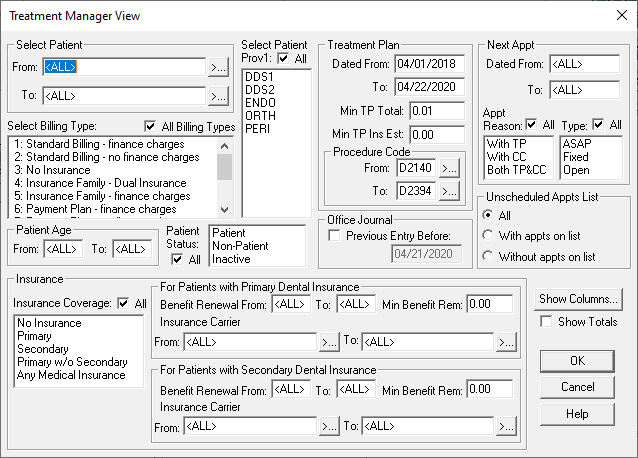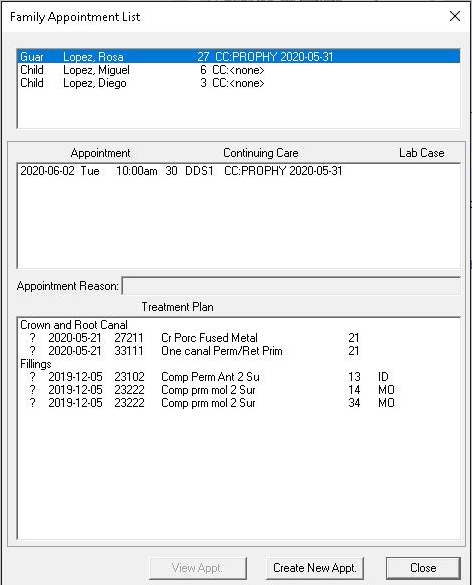Building a strong schedule and keeping it full is one of the most important and most challenging tasks for your team members at the front desk. As you and your team work to rebuild your schedule when the office opens again after a long closure or as you work to fill holes in the schedule, you can use the Treatment Manager to make the task easier.
What is the Treatment Manager? The Treatment Manager is a secondary module within the Appointment Book and Chart modules that helps you find patients with specific types of procedures. You can set criteria to find patients with the right type of treatment needs to fill time in your schedule.
For example, you can use the Treatment Manager to find patients who have four surface fillings treatment planned so you can contact them and encourage them to schedule treatment before it turns into a more serious type of restoration. Or, if you are looking for high production value procedures, you could use the Treatment Manager to find patients who need crowns so you can get them on the schedule as soon as possible. You can set the criteria in the Treatment Manager based on your scheduling needs right now.
Scheduling from the Treatment Manager
To open the Treatment Manager and generate the list, open the Appointment Book and select Options, then Treatment Manager. From the Treatment Manager View window, you can establish the criteria you are searching for to fill the holes in your Appointment Book.

Do you want to use any procedures to fill the holes, or do you only want to use crown codes? Do you want to focus on patients whose production is over a certain dollar amount? It is your choice to decide what will work best for your schedule and your production goals. You can also choose patients who have primary insurance, no insurance, and so forth so you can call patients who are likely to accept the open appointment.
When you click OK, the Treatment Manager will generate a list of patients with outstanding treatment procedures.

By default, the patients are listed in alphabetical order. You can click on the column headings to sort the list the way you want to see the data. If you’re looking for patients who have needed treatment the longest, click the Last TP column heading, and it will sort the treatment with the oldest plan first. To find the highest-value treatment plan, click the TP Total column heading. Now your search begins! Find the right patients to contact to build your schedule.
When you double-click on any patient’s name in the Treatment Manager, the Family Appointment List dialog box appears.

The patient’s treatment plan is listed in the lower part of the dialog box. Call your patient and if the patient is ready to schedule his or her outstanding treatment, click Create New Appointment. You can make an appointment for your patient right from the Treatment Manager. It’s that easy.
And because the Treatment Manager is a secondary module in Dentrix, you can access any other Dentrix module from the toolbar in the Treatment Manager. With a mouse click, you can easily switch between modules to view patient balances, treatment cases, insurance information, and patient’s dental activity.
The Treatment Manager is accessible from the Appointment Book and the Patient Chart. Next time your office is having difficulty filling holes in the Appointment Book, use the Treatment Manager to optimize your schedule and increase your daily production.
Bonus Tip: Finding Patients with Immediate Treatment Needs
You can use the Treatment Manager to find patients with specific types of procedures who may need to come in for treatment ASAP. But there’s another tool in Dentrix you can use to find patients who have treatment cases that were marked as urgent in the Treatment Planner. It’s called the Treatment Case Report.
To generate the Practice Treatment Case Report, in the Treatment Planner, click File > Print > Practice Treatment Case Report. In the filter options for the report, set the Case Severity search criteria to Immediate. That way the report will find all the treatment plans within the date range you set that were marked as Immediate (the most urgent case severity setting.)
For more information, see the Treatment Manager Overview and Printing Practice Treatment Case Reports topics in Dentrix Help.




